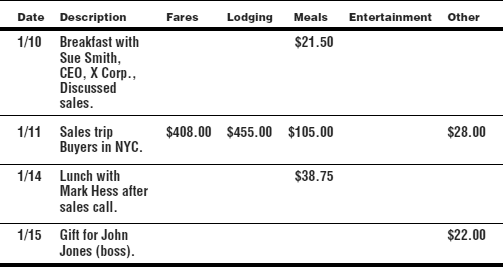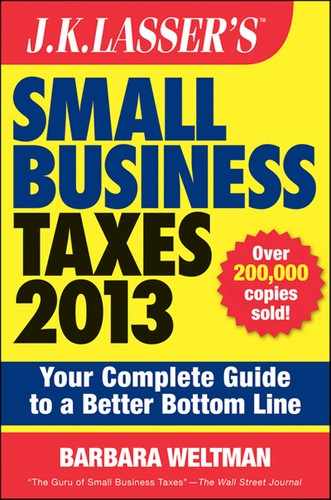Recordkeeping Requirements
Business expenses can be disallowed unless there is adequate substantiation for the expenses claimed. For travel and entertainment expenses, there are 2 main ways to prove costs: actual substantiation, or reliance on a per diem rate. First look at actual substantiation; then consider how recordkeeping can be simplified with the use of per diem rates.
There are a number of elements to substantiate for each business expense. In general, to substantiate each item you must show the amount, the time, the place, the business purpose for the travel or the business relationship with the persons you entertain or provide gifts to, and, in some cases, a description of the item. The exact type of substantiation required depends on the item of business expense.
Travel
You must show the amount of each separate expense for travel, lodging, meals, and incidental expenses. You can total these items in any reasonable category. For example, you can simply keep track of meals in a category called daily meals. You must also note the dates you left for the trip and returned, as well as the days spent on the trip for business purposes. You must list the name of the city or other designation of the place of the travel, along with the reason for the travel or the business benefit gained or expected to be gained from it.
While this may sound like a great deal of recordkeeping, as a practical matter hotel receipts may provide you with much of the information necessary. For example, a hotel receipt typically shows the dates you arrived and departed; the name and location of the hotel; and separate charges for lodging, meals, telephone calls, and other items. The IRS says that a charge slip for hotel costs is no substitute for the hotel receipt itself. You must have documentary evidence for the cost of lodging. You do not need documentary evidence if the item (other than lodging) is less than $75 or, in the case of transportation costs, if a receipt is not readily available. Thus, if a cab ride is $9 and the driver does not provide you with a receipt, you are not required to show documentary evidence of this expense.
Meals and Entertainment
List expenses separately. Incidental expenses, such as taxis and telephone, may be totaled on a daily basis. List each date of the meal or entertainment. For meals or entertainment directly before or after a business discussion, list the date and duration of the business discussion. Include the name and address or location of the place for the entertainment and the type of entertainment if not apparent from the name of the place. Also list the place where a business discussion was held if entertainment was directly before or after the discussion. State the business reason or the business benefit gained or expected to be gained and the nature of the business discussion. Include the names of the persons entertained, including their occupations or other identifying information, and indicate who took part in the business discussion.
If the deduction is for a business meal, you must note that you or your employer was present at the meal. Again, a restaurant receipt typically will supply much of the information required. It will show the name and location of the restaurant, the number of people served, and the date and amount of the expense. Be sure to jot down the business aspect of the meal or entertainment, such as asking a client for a referral or trying to sell your services.
Gifts
Show the cost of the gift, the date given, and a description. Also show the business reason for the gift or the business benefit gained or expected to be gained from providing it. Indicate the name of the person receiving the gift, his or her occupation or other identifying information, and his or her business relationship to you.
A canceled check, along with a bill, generally establishes the cost of a business item. A canceled check alone does not prove a business expense without other evidence to show its business purpose.
TABLE 8.2 Sample Expense Diary

Using a Diary or Log
Enter your expenses in a diary (see Table 8.2) or log at or near the time of the event giving rise to the expenses. Computer-generated records are acceptable. Be sure to include all the elements required for the expense (especially the business reason for it).
It is a good idea to total expenses on a monthly basis and then use a recap form to put annual figures together.
Other Substantiation Methods
The IRS has recognized we are in the computer age and has endorsed various computer-based substantiation methods. For example, if each employee has a company credit card, electronic reports from the credit card company can be used to substantiate charged expenses (paper receipts of expenses in excess of $75 are still required).
Missing, Lost, or Inadequate Records
If you do not have adequate records, you may still be able to deduct an item if you can prove by your own statement or other supporting evidence an element of substantiation. A court may even allow an estimation of expenses under the “Cohan rule,” under certain circumstances. Where receipts have been destroyed, you may be able to reconstruct your expenses. You must, of course, show how the records were destroyed (fire, storm, flood). The IRS may require additional information to prove the accuracy or reliability of the information contained in your records. Recordkeeping alternatives are discussed in more detail in Chapter 3.
Per Diem Rates
If you receive reimbursement using one of the per diem rates discussed earlier, you need not retain documentary evidence of the amount of an expense. The per diem rate is deemed to satisfy the proof of the amount of the expense. However, use of the per diem rate does not prove any of the other elements of substantiation. For example, if an employee is reimbursed for business travel using the high-low method, he or she still must show the time, the place, and the business purpose for business travel.
